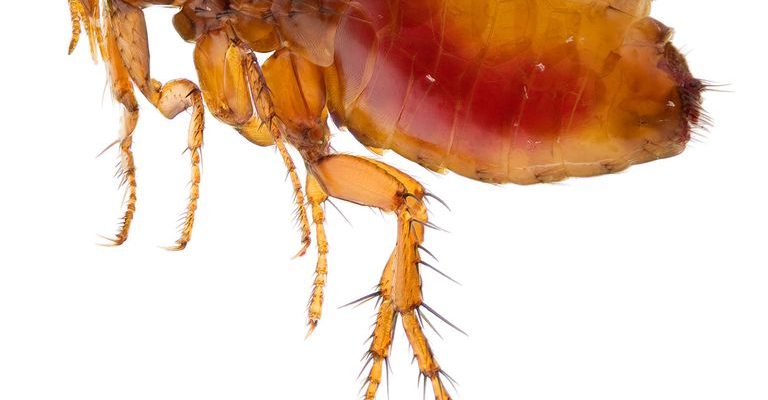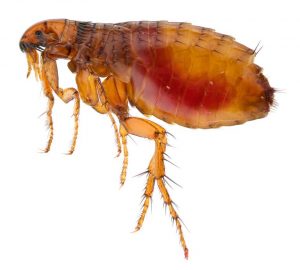How To Prevent Fleas
- July 29, 2019
- in Pest Control
- by Ashley Dando
- 82
- 0

Fleas can be a common problem for pet owners, and they can appear suddenly, even if your pet never had any issues before. They are small insects with no wings, and with legs designed for jumping. They are usually caught outdoors, from other pets (those of your friends, your neighbours or those in the dog park) or from wild animals (rabbits, birds, cats, etc.) Although fleas do not usually feed with human blood, you can still carry them on your body from the above-mentioned sources. Fleas can survive in a home even if there are no pets, as long as there are animals that shelter nearby. They can go for 100 days without a host and can multiply quickly. In this article, we will discuss how to get rid of and how to prevent fleas.
While fleas do not harm people, they can definitely cause a lot of harm to your beloved furry friends. First of all, they cause irritation of their skin, which then makes them scratch and irritate the area even more. But this is the least worrying issue, as fleas can also transmit various diseases, including plague from wild animals and tapeworms (that can also be transmitted to people).

So it is very important to take action as soon as you see any signs of flea infestation.
There are various flea treatment products online, in supermarkets and at pet shops and veterinary cabinets, so it’s important to read the label and use the right type of product for your own pet (depending on their species, age, and weight).
– Step 1: eliminate existing adult fleas on your pet – This can be achieved through a product designed for this purpose, and it is important to get a recommendation from your veterinarian, instead of buying random products from the store. Be very careful with small pets as they need a really small dose, while larger dogs may need larger quantities of products.
– Step 2: wash your pet – Washing is highly important, especially for dogs that spend a lot of time outdoors and get in contact with other pets. By frequently washing/showering your pet, you can eliminate existing adult fleas, as well as their eggs and larvae.
– Step 3: treat your home – fleas may jump off your pet when you are petting or brushing it, and hide in carpets, upholstery or baseboards. So it is important to treat these areas with a pesticide product designed to kill indoor fleas, or even better, call a pest control company.
– Step 4: Treat your yard – to protect dogs that spend a lot of time in your back yard, you can use products designed for outdoor spaces, or you can discuss this with your pest control technician. Definitely, do not apply these substances directly on your pet, but in various places around the yard.
– Step 5: Wait – allow pesticides to dry for about 3 to 5 hours before letting your pet back in the home or yard. When applying products indoors, make sure to air out the entire home and do not clean the treated areas for 2 weeks after the treatment.
There are various methods to prevent these nasty insects, and they include:
– Avoid infested places/animals – if you have clear indications that a place or another pet or wild animal has fleas, make sure to keep your pet away from there, as well as yourself. As mentioned before, humans can become a great means of transportation for fleas, allowing them to easily get from one animal to another.
– Wash your pet frequently – this rule especially applies to dogs who spend a lot of time outdoors and interact with other animals on a regular basis. Ask for indications from your veterinarian or do some research online regarding how often it is ok to wash your dog. This may differ based on breed, age, size, length of the fur, etc.
– Use flea prevention products – there are various flea control products out there, including pills that are given to the pet once a month, collars that are replaced every six months or topical medications that are applied between the shoulder blades. Make sure to use the right product according to your pet’s age, breed, and size. In warm areas, these products should be used all year round, while in colder climates only during flea seasons, as they tend to become inactive during the winter.
– Clean your home – since they can live and breed in various fabrics and carpets, it is important to regularly clean and vacuum floors, carpets, upholstery or baseboards. Also make sure to discard the dust bag from the vacuum after every use, preferably in outdoor garbage that is not in the reach of your pet.
Flea bites can be very itchy and painful, and can also trigger allergic reactions in humans. While they cannot survive only with human blood, they can still bite humans as well.
Flea bites are usually small, with a central red spot and appear in groups of three or four, or sometimes in a line. Blisters do not form on flea bites, but only on those of bed bugs. Humans are usually bitten on the feet or ankles, but fleas can expand to other areas of the body too, especially on people with dense hair on the legs and chest.
Humans are not the most optimal hosts for fleas, but they can be a secondary option until a better source of food is found. Especially if the flea is really hungry and didn’t have a host for many days. Most people will be ok, but others can develop serious allergic reactions.
Besides the obvious sight of fleas on the fur of your pet, here are other ways for identifying them:
– Scratching, licking or biting – if your pet is unusually scratching their head, neck, tail, armpits or groin, then they may have fleas, as those are some of the common places they like to hide
– Red patches or bites – some pets can also get an allergic reaction from fleas, which can develop on any part of the body, not just where the bites occurred. So if your pet has unusual red patches, consult your vet as soon as possible
– Hair loss – this can happen for two reasons: either because of the allergic reaction caused by the flea bites, either because the pet is pulling out its own hair because of continuous biting or licking of the bitten areas
– Pale gums – this can be a sign of anemia, which may be caused by fleas. This is because of a serious infestation that causes a lot of loss of blood.
– Flea dirt – if you notice small black or reddish dots on your pet’s body or around the home, they may be the feces of fleas (digested blood).
There are various types of fleas out there, and here are the most common ones:
Adult cat fleas are dark brown or black and about ¼ inch long. When viewed from the side, their body appears to be hardened and compressed. Their bites are not dangerous alone, but they can transmit various diseases to humans, cats, and dogs.
They have a similar look to cat fleas and are often confused. The main differences are only visible through a microscope. If possible, they stick to a single host and feed on it throughout their entire life. When removed, they will search for a new host.
Both the cat fleas and the dog fleas can be found on either of the hosts. So it’s not unusual to find dog fleas on a cat or vice versa.
They are also brownish in colour and very small (5/16 in. or 0.79 cm). They are most prevalent in the spring when birds are nesting and raising their young ones. The larvae feed on materials found in the birds’ nests, while the adults develop in the autumn and remain in their cocoons until the next spring. Their jumps are triggered by shadows. They can cause anemia or even death to young birds.
If your home or yard is seriously infested by fleas, then it’s time to call a specialist! Safeguard Pest Control is a family-owned and operated company that has been operating since 1989. We have extensive knowledge and experience in this field and can provide you with professional results.
Book your Safeguard fleas inspection and treatment now by calling 07 5477 6675 or emailing info@safeguardpestcontrol.com.au and allow us to protect your home against fleas.